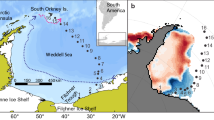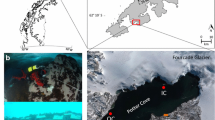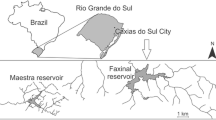Abstract
Ceratium tripos dominated a multi-species dinoflagellate patch in the sub-surface chlorophyll maximum in August 1978 on the Southern California shelf. The specific growth rate (μ) ofC. tripos averaged 0.25 d-1. Patch length was about 45 km along the shelf. Several members of the subsurface dinoflagellate assemblage were also present in surface samples, but only during the daytime. These apparent vertical migrators includedProrocentrum micans, C. furca, Gonyaulax polyedra and other less common forms. The growth ofC. tripos in the California patch is compared with that in aC. tripos patch off New York in 1976.
Similar content being viewed by others
Literature cited
Cullen, J. J., F. M. H. Reid and E. Stewart: Phytoplankton in the surface and chlorophyll maximum off southern California in August, 1978. J. Plankton Res.4, 665–694 (1982a)
Cullen, J. J., E. Stewart, E. Renger, R. W. Eppleyand C. D. Winant. Vertical motion of the thermocline, nitracline and chlorophyll maximum layers in relation to currents on the southern California shelf. J. mar. Res.41, 239–262 (1982b)
Elbrächter, M.: Population dynamics ofCeratium in coastal waters of the Kiel Bay. Oikos (Suppl.)15, 43–48 (1973)
Eppley, R. W. and W. G. Harrison: Physiological ecology ofGonyaulax polyedra, a red water dinoflagellate of southern California.In: Proceedings of First International Conference on Toxic Dinoflagellate Blooms, pp 11–22. Ed. by V. R. LoCicero. Wakefield, Mass.: Massachusetts Science and Technology Foundation 1975
Estrada, M. and D. Blasco: Two phases of the phytoplankton community in the Baja California upwelling. Limnol. Oceanogr.24, 1065–1080 (1979)
Falkowski, P. G., T. S. Hopkins and J. J. Walsh: An analysis of factors affecting oxygen depletion in the New York Bight. J. mar. Res.38, 479–506 (1980)
Hasle, G. R.: Phototactic vertical migration in marine dinoflagellates. Oikos2, 162–175 (1950)
Hasle, G. R. and E. Nordli: Form variation inCeratium fusus andtripos populations in cultures and from the sea. Skr. norske Vidensk-Akad. Mat.-naturv. Kl4, 1–25 (1951)
Holligan, P. M.: Patchiness in subsurface phytoplankton populations on the northwest european continental shelf.In: Spatial pattern in plankton communities, pp 221–238. Ed. by J. H. Steele. New York: Plenum Press 1978
Holmes, R. W., P. M. Williams and R. W. Eppley: Red water in La Jolla Bay, 1964–1966. Limnol. Oceanogr.12, 503–512 (1967)
Kierstad, H. and L. B. Slobodkin: The size of water masses containing plankton blooms. J. mar. Res.12, 141–147 (1953)
Lorenzen, C. J.: A method for the continuous measurement ofin vivo chlorophyll concentration. Deep-Sea Res.13, 223–227 (1966)
Malone, T. C.: The 1976Ceratium tripos bloom in the New York Bight: causes and consequences. Circ. U.S. natn. mar. Fish. Serv. (U.S. Dep. Comm.)410, 1–14 (1978)
Malone, T. C., W. Esaias and P. Falkowski: Part 1. Water column processes, Chapter 9. Plankton dynamics and nutrient cycling.In: Oxygen depletion and associated benthic mortalities, pp 193–217. Ed. by R. L. Swanson and C. J. Sindermann. Washington, D.C.: U.S. Department of Commerce 1979. (NOAA Prof. Pap. No. 11)
McDuff, R. E. and S. W. Chisholm: The calculations ofin situ growth rates of phytoplankton populations from fractions of cells undergoing mitosis: a clarification. Limnol. Oceanogr.27, 783–788 (1982)
Nordli, E.: Experimental studies on the ecology ofCeratia. Oikos8, 200–252 (1957)
Okubo, A.: Oceanic diffusion diagrams. Deep-Sea Res.18, 789–802 (1971)
Okubo, A.: Horizontal dispersion and critical scales of phytoplankton patches.In: Spatial patterns in plankton communities, pp 21–42. Ed. by J. H. Steele. New York: Plenum Press 1978
Platt, T.: Local phytoplankton abundance and turbulence. Deep-Sea Res.19, 183–187 (1972)
Reid, F. M. H., E. Stewart, R. W. Eppley and D. Goodman: Spatial distribution of phytoplankton species in chlorophyll maximum layers off southern California. Limnol. Oceanogr.23, 219–226 (1978)
Revelante, N., W. T. Williams and J. S. Bunt: Temporal and spatial distribution of diatoms, dinoflagellates andTrichodesmium in waters of the Great Barrier Reef. J. exp. mar. Biol. Ecol.63, 27–45 (1982)
Seliger, H. H., K. R. McKinley, W. H. Biggley, R. B. Rivkin and K. R. H. Aspden. Phytoplankton patchiness and frontal regions. Mar. Biol.61, 119–131 (1981)
Smith, R. C. and K. S. Baker: Oceanic chlorophyll concentrations as determined by satellite (Nimbus-7 coastal zone color scanner). Mar. Biol.66, 269–279 (1982)
Staker, R. D. and S. F. Bruno: Diurnal vertical migration in marine phytoplankton. Botanica mar.23, 167–172 (1980)
Steele, J. H. (Ed.). Spatial patterns in plankton communities, 470 pp. New York: Plenum Press 1978
Strathmann, R. R.: Estimating the organic carbon content of phytoplankton from cell volume or plasma volume. Limnol. Oceanogr.12, 411–418 (1967)
Strickland, J. D. H. and T. R. Parsons: A practical handbook of seawater analysis, 2nd ed. Bull. Fish. Res. Bd Can.167, 1–310 (1972)
Traganza, E. D., J. C. Conrad and L. C. Breaker: Satellite observations of a cyclonic upwelling system and giant plume in the California current.In: Coastal upwelling, pp 228–241. Ed. by F. A. Richards. Washington, D.C.: American Geophysical Union 1981
Tyler, M. A. and H. H. Seliger: Annual subsurface transport of a red tide dinoflagellate to its bloom area: water circulation patterns and organism distributions in the Chesapeake Bay. Limnol. Oceanogr.23, 227–246 (1978)
Von Stosch, H. A.: Zum Problem der sexuellen Fortpflanzung in der PeridineengattungCeratium. Helgoländer wiss. Meeresunters.10, 140–152 (1964)
Weiler, C. S. and S. W. Chisholm: Phased cell division in natural populations of marine dinoflagellates from shipboard cultures. J. exp. mar. Biol. Ecol.25, 239–247 (1976)
Whittaker, R. H.: A study of summer foliage insect communities in the Great Smoky Mountains. Ecol. Monogr.22, 1–44 (1952)
Winant, C. D. and L. W. Bratkovich: Temperature and currents on the southern California shelf: a description of the variability. J. phys. Oceanogr.11, 71–86 (1981)
Author information
Authors and Affiliations
Additional information
Communicated by N.D. Holland, La Jolla
Rights and permissions
About this article
Cite this article
Eppley, R.W., Reid, F.M.H., Cullen, J.J. et al. Subsurface patch of a dinoflagellate (Ceratium tripos) off Southern California: Patch length, growth rate, associated vertically migrating species. Mar. Biol. 80, 207–214 (1984). https://doi.org/10.1007/BF02180188
Accepted:
Issue Date:
DOI: https://doi.org/10.1007/BF02180188




